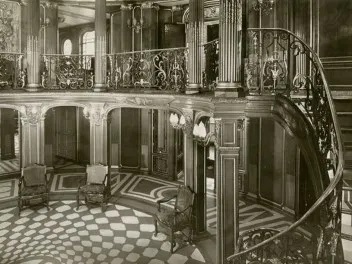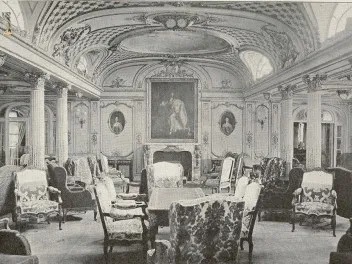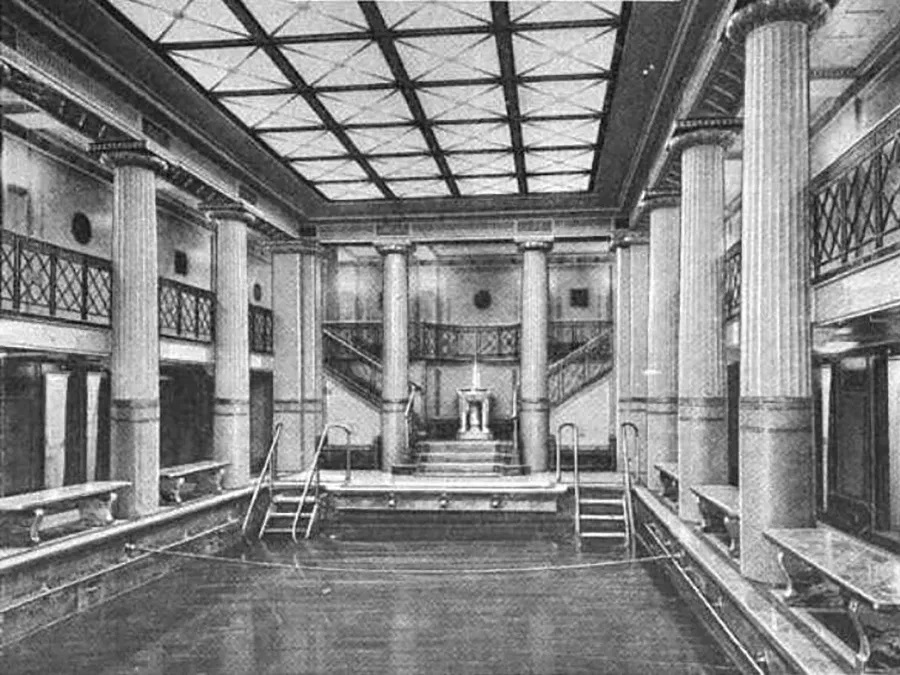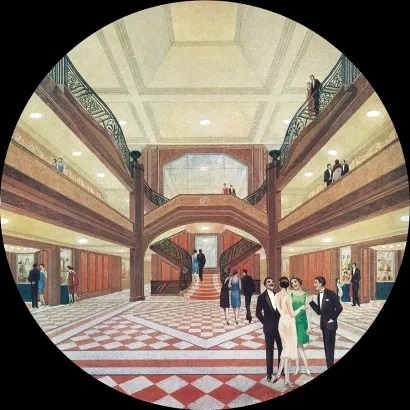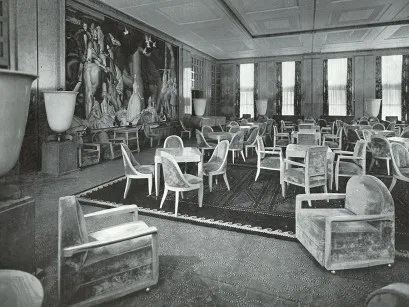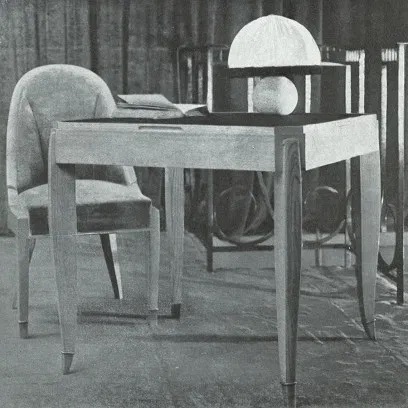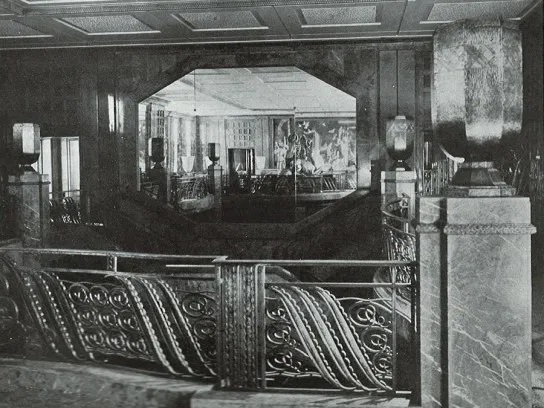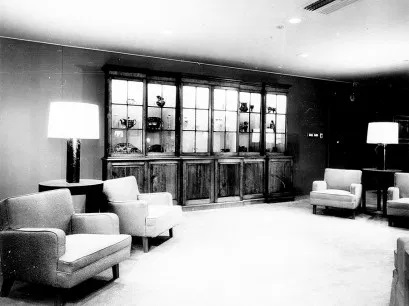The Allure of Ocean Liners: Decorative Arts Afloat
Outside of his work at the Decorative Arts Trust, Membership Coordinator Christian Roden writes and lectures on the topic of ocean liners. His first publication, “Henry Dreyfuss Designs the Postwar Ocean Liner” will appear in the upcoming issue of the Winterthur Portfolio. While his interests also encompass the technological, political, and economic influences exerted to run ocean liners in the 20th century, he can rarely resist the chance to talk about their fabulous interiors. The following blog is excerpted from two of his recent research projects.
People love ocean liners for many reasons. Some are drawn to the drama of the stories of the Titanic or Andrea Doria, or at least through the drama of blockbuster shipwreck films, such as the eponymous Titanic or The Poseidon Adventure. Others come to the subject through family or personal history. America being a nation of immigrants, vast swaths of the population don’t have to look too far back in their family tree to find a generation that was fresh off the boat. The majority of ocean liner enthusiasts, however, adore the topic because of the fantastic interiors and decorative arts found onboard these ships during their heyday. Much like the interiors of contemporary buildings on land, these spaces reflected the aesthetics, social customs, and values of their era.
Although the earliest true ocean liners date to the 1840s, they began coming into their own as technological and decorative marvels in the 1880s. At that point, their interior accommodations became a selling point for the companies, even though the vast majority of the passengers who sailed on these ships did so as immigrants in the sometimes appalling conditions of steerage class. Nevertheless, publicity focused on the luxuries of First Class, which embraced the fashionable trends of the era, including the many revival styles of the late 19th and early 20th centuries. As with the great houses of the wealthy, a variety of time periods and cultures served as inspiration. Although Jacob van Falke was writing about land-based interiors, his observations that the wealthy man “dwells in the eighteenth century, he sleeps in that century likewise, but he dines in the sixteenth, then on occasion he smokes his cigar and enjoys his coffee in the Orient, while he takes his bath in Pompeii” holds true for the great early liners.
Inspired by the Renaissance Style of Francis I. Each of the hand-carved oak panels and columns was unique.
The Mauretania’s First Class Lounge, on the other hand, jumped forward three centuries to Louis XVI style.
The First Class entrance of the SS France was a recreation of the lobby Bibliotheque Nationale of Paris. Today the paneling, ironwork, and a few light fixtures remain in the collection of the Association French Line Archives in Le Havre, France.
Other first class spaces on the SS France relied on architectural details copied form Versailles. The portrait of Louis XIV was merely a finishing touch.
Despite their nods to the past, the liners proudly used the latest technology and products. Walls on the RMS Servia of 1883 proudly featured Lincrusta coverings, a linoleum-like composite of linseed oil and wood powder that could be applied like wallpaper, but possessed the three-dimensional qualities of wood or plaster moldings. Subsequent liners introduced features such as electric lights, elevators, hydraulic barber chairs, and swimming pools. Although fairly common on land, these features’ presence on board signaled an increasing focus on passenger comfort and an equal distancing from the dangerous and uncomfortable conditions that had plagued travelers for centuries.
As with most things related to the latest fashions, we have the French to thank for taking modernism to sea. As soon as the 1925 World’s Fair, also known as L’Exposition Internationale des Arts Decoratifs ets Industriels Modenres, had closed down, officials from the French Line hired the best and brightest new decorators showcased there to furnish their latest ocean liner. Launched in 1927, the S.S. Ile de France was the first ship to use the Art Deco style, and for the line’s American clientele, was one of their first brushes with truly modern design. The late maritime historian John Maxtone-Graham probably said it best in describing her as “the great divide from which point on decorators reached forward rather than back.”
Table and chair designed by Emile-Jacques Ruhlmann for the Ile de France. Image courtesy of the author.
Take, for example, the first class staircase and tea room. Although technically rooms with two functions, they shared a space, and were united by the staircase’s four story open atrium (the first of its kind on-board of a ship, and now a popular feature on cruise ships). The custom furniture throughout the tea room, including the piano, was specially designed by the renowned French cabinetmaker Emile-Jaques Ruhlmann in the signature style he had introduced at the 1925 exposition, subtly reinforced to withstand not only the movement of the ship during storms, but also constant hard use from the 700 first class passengers who traveled on each voyage. The tea room complemented the first class entrance foyer designed by Richard Bouwens de Boijen, which featured decorative ironwork by Edgar Brandt.
Modernism in one form or another remained the preferred decorative trend through the 1950s. By then, the major national shipping companies of England, Germany, France, Italy, and the United States had produced vessels that competed to be the largest, fastest, and most luxurious liners on the North Atlantic routes. Newspapers of the day referred to them as “floating embassies,” and indeed many world leaders regularly used them not just to travel the world on state visits, but to conduct business with local officials whenever these vessels were docked in foreign ports.
Even smaller vessels, that could not be rightly termed “ships of state,” embraced these nationalistic tendencies. Two such vessels were the Independence and Constitution, the work of noted industrial designer Henry Dreyfuss, and the subject of Christian’s article and master’s thesis. The theme of Dreyfuss’s work was “Modern American Living at Sea,” a subject made literal both by the names of the vessels and their interiors. Aesthetically based in the Mid-Century Modern style, passenger spaces in all three classes were named, however, after historic American figures or maritime traditions. The centerpieces of these vessels were the First Class lounges, named after their respective ships. The furniture, upholstery and curtains were all custom modern designs, but were designed to harmonize with specific historic references. At the forward end of each room a small alcove painted flag red emphasized a framed replica of the founding document associated with each ship: the Declaration of Independence on the Independence and the Constitution of the United States on the Constitution. Underneath, an antique console table supported by a large eagle highlighted the patriotism of the ship’s heritage. Against the aft wall, a reproduction pine breakfront housed a unique display of American decorative arts.
View of the breakfront and decorative arts display in the SS Independence. Image courtesy of the Cooper-Hewitt, Smithsonian Design Museum.
Dreyfuss, a big fan of museums, exerted his influence and charm to arrange for rotating loans of silver, pewter, glassware, and ceramics on loan from the Metropolitan Museum of Art, an arrangement that has never been subsequently replicated. Even the upholstery for the sofas and curtains used a printed linen featuring abstracted birds. Advertisements claimed these were inspired by Audubon prints, although to the casual observer this was a tenuous connection at best. Perhaps brash, and occasionally verging into the kitschy, these interiors paid homage to the ships’s “American-ness” that had been part of the company’s brand identity since the 1930s.
Although ocean liners remained a popular method of travel through the end of the 1960s, their legacy faces the same challenges many preservationists will find familiar. As commercial enterprises, they were typically scrapped once their useful life was over. With their furniture and fixtures scattered to the winds, appreciating their function not just as agents of cultural exchange, but as extremely important reasons for the creation, display, and use of the decorative arts becomes assumes increasing importance. Only five true ocean liners survive, three of which are museums. The preservation not just of artifacts, but of the documentation connected to these grand and culturally significant vessels, will be a challenge in years to come.
About The Decorative Arts Trust Bulletin
Formerly known as the "blog,” the Bulletin features new research and scholarship, travelogues, book reviews, and museum and gallery exhibitions. The Bulletin complements The Magazine of the Decorative Arts Trust, our biannual members publication.










